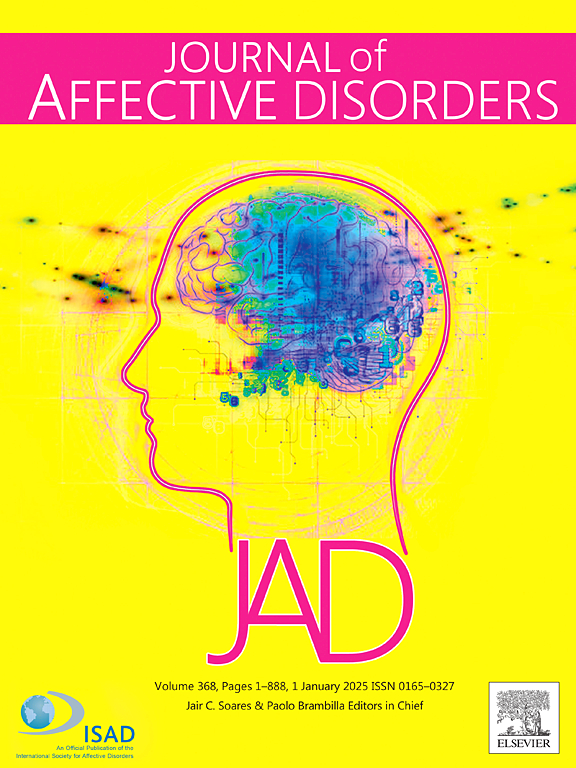Machine learning models of depression in middle-aged and older adults with cardiovascular metabolic diseases
IF 4.9
2区 医学
Q1 CLINICAL NEUROLOGY
引用次数: 0
Abstract
Background
The incidence of cardiovascular metabolic diseases (CMD) is increasing, and depression in CMD patients significantly impacts prognosis. Therefore, this study aimed to develop and validate a predictive model for depression in CMD patients using machine learning methods.
Methods
The study utilized data from the Survey of Health, Ageing, and Retirement in Europe (SHARE) for model derivation and internal validation, and data from the China Health and Retirement Longitudinal Study (CHARLS) for external validation. Logistic Regression, K-nearest neighbors, Support Vector Machine, Random Forest, Gradient Boosting Machine (GBM), and Light Gradient Boosting Machine were used to construct depression prediction models. The model performance was assessed mainly using area under the receiver operator characteristic curve (AUC), brier score, calibration plots and decision curve analysis (DCA). Model interpretations were generated using the Shapley additive explanations (SHAP) method.
Results
Among the 14,884 participants in SHARE and 1128 in CHARLS, 5456 and 474 had depression, respectively. The Gradient Boosting Machine (GBM) model demonstrated the best performance in terms of discrimination and calibration, with an AUC of 0.823 in the external validation cohort, and the DCA also verified that the GBM model had the best clinical practicality. The SHAP method revealed that trouble sleep, life satisfaction and loneliness were the top 3 predictors of depression. For the convenience of clinicians, we developed a clinical support system based on GBM model.
Conclusions
We integrated the GBM model into a clinical support system which could assist clinicians in early identifying CMD patients at high risk for depression.
中老年人心血管代谢疾病患者抑郁症的机器学习模型。
背景:心血管代谢性疾病(CMD)的发病率正在上升,而CMD患者的抑郁对预后有显著影响。因此,本研究旨在利用机器学习方法开发和验证CMD患者抑郁的预测模型。方法:采用欧洲健康、老龄化和退休调查(SHARE)的数据进行模型推导和内部验证,采用中国健康与退休纵向研究(CHARLS)的数据进行外部验证。采用Logistic回归、k近邻、支持向量机、随机森林、梯度增强机(GBM)和光梯度增强机构建洼地预测模型。主要通过接收算子特征曲线下面积(AUC)、brier评分、标定图和决策曲线分析(DCA)对模型性能进行评价。使用Shapley加性解释(SHAP)方法生成模型解释。结果:在SHARE的14884名参与者和CHARLS的1128名参与者中,分别有5456名和474名患有抑郁症。在外部验证队列中,梯度增强机(Gradient Boosting Machine, GBM)模型在鉴别和校准方面表现最佳,AUC为0.823,DCA也验证了GBM模型具有最佳的临床实用性。SHAP方法显示,睡眠问题、生活满意度和孤独感是抑郁症的前三大预测因素。为了方便临床医生,我们开发了一个基于GBM模型的临床支持系统。结论:我们将GBM模型整合到临床支持系统中,该系统可以帮助临床医生早期识别具有抑郁症高风险的CMD患者。
本文章由计算机程序翻译,如有差异,请以英文原文为准。
求助全文
约1分钟内获得全文
求助全文
来源期刊

Journal of affective disorders
医学-精神病学
CiteScore
10.90
自引率
6.10%
发文量
1319
审稿时长
9.3 weeks
期刊介绍:
The Journal of Affective Disorders publishes papers concerned with affective disorders in the widest sense: depression, mania, mood spectrum, emotions and personality, anxiety and stress. It is interdisciplinary and aims to bring together different approaches for a diverse readership. Top quality papers will be accepted dealing with any aspect of affective disorders, including neuroimaging, cognitive neurosciences, genetics, molecular biology, experimental and clinical neurosciences, pharmacology, neuroimmunoendocrinology, intervention and treatment trials.
 求助内容:
求助内容: 应助结果提醒方式:
应助结果提醒方式:


